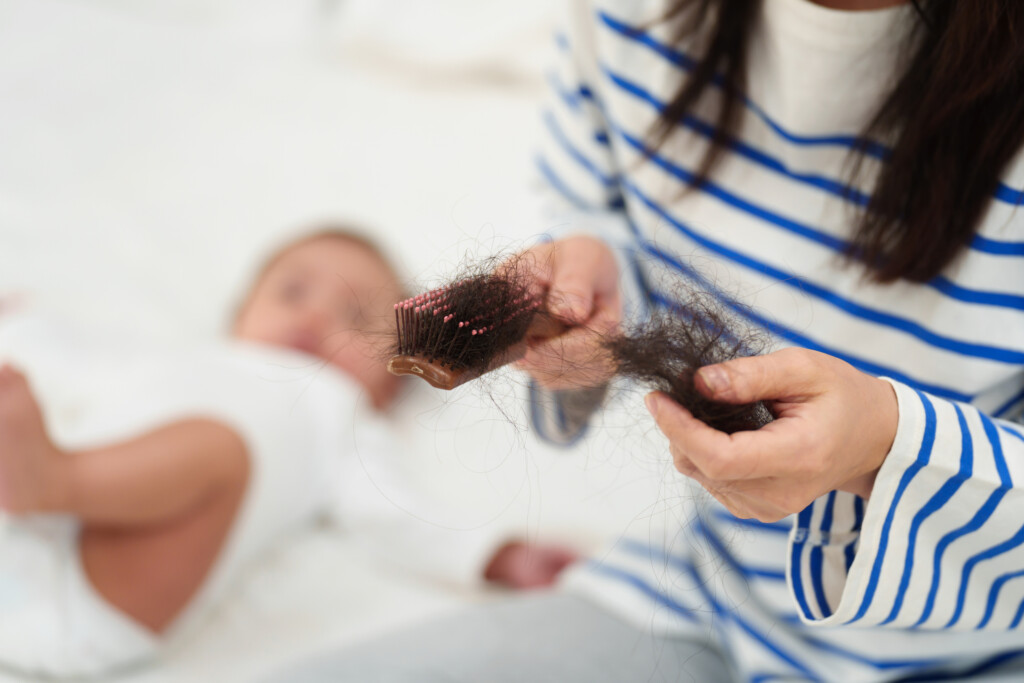
Dealing with postpartum hair thinning is a challenge many new mothers overlook after giving birth.
Hormonal changes can lead to increased hair shedding or noticeable thinning, which can cause worry when hair is found on pillows, in shower drains and in hairbrushes.
This condition significantly affects many mothers, whether it’s the first time or not.
While it’s hard to give exact numbers, the American Pregnancy Association suggests that 40-50% of new mothers experience hair loss after childbirth.
At MD Cosmetic, we’ve found that Platelet-Rich Plasma (PRP) therapy shows promising results in promoting hair growth and thickness.
In this post, you’ll learn tips on how to stop postpartum hair loss.
Why Does Hair Change After Pregnancy
During pregnancy, increased estrogen levels can lead to thicker and more luxurious hair due to an extended growth phase.
However, after childbirth, estrogen levels drop, which can cause many hair follicles to enter the shedding phase simultaneously, resulting in noticeable thinning or substantial hair loss.
Postpartum hair loss typically begins around two months after delivery and can continue for several months, gradually improving as the baby reaches six months to a year of age.
Platelet-rich plasma (PRP) therapy addresses ongoing hair thinning, especially when it persists.
What is PRP Hair Treatment?
Platelet-rich plasma (PRP) therapy is a non-surgically, minimally invasive treatment that stimulates hair growth and reduces hair loss using your body’s concentrated platelets.
PRP is a potent substance from a blood component rich in growth factors. When applied to the scalp, it encourages the growth of new hair.
To achieve the best outcomes using PRP for hair loss, we typically recommend 4-6 sessions. Although individual results may differ, changes are usually noticeable six months after the initial treatment.
PRP therapy is effective compared to commonly used hair loss treatments. In contrast to medications like Minoxidil, which may produce results but require ongoing use and can have side effects, PRP therapy offers a promising alternative.
On the other hand, hair transplant surgeries provide a more enduring solution but are invasive, costly and involve prolonged recovery periods and associated risks.
PRP therapy is efficient and secure, bypassing the scarring, infections and systemic side effects of medications and hair transplants.
PRP Hair Procedure Steps
The PRP therapy process has three steps:
- Blood Separation Process: A small blood sample is placed in a centrifuge to separate the platelet-rich plasma (PRP) from the red blood cells.
- Scalp Application: The PRP is injected directly into the scalp at the hair follicle level to target areas of thinning or hair loss.
- Follicle Stimulation: The growth factors in the PRP stimulate the hair follicles, promoting thicker hair growth.
PRP Benefits for Hair
The benefits of platelet-rich plasma (PRP) therapy are closely connected to its characteristics.
- Minimally invasive treatment: This therapy uses your body’s platelets to stimulate hair follicle growth with minimal downtime naturally.
- Minimized adverse reactions: PRP therapy uses your blood, significantly reducing the risk of side effects such as allergic reactions.
- Increased hair thickness and density: Regular PRP sessions can lead to thicker, denser hair, improving overall hair volume and appearance.
PRP Side Effects for Hair
The typical side effects of PRP treatment are generally mild and short-lived. These may include redness, swelling, itching, headache, numbness and discomfort in the treated area.
No severe side effects such as hematoma, panniculitis or allergic reactions have been reported after the treatment.
Extra Hair Care Tips
Keep in mind the following healthy hair care tips in addition to this treatment to maintain the health of your hair and minimize the risk of hair loss.
These tips involve:
- Maintain a healthy diet: Ensure your diet is rich in iron, Vitamin C, Vitamin D, Omega-3 fatty acids, and beta-carotene. These essential nutrients promote hair growth and strength, contributing to overall hair health.
- Avoid tight hairstyles: Avoid tight hairstyles like braids or ponytails to reduce strain on your hair follicles and prevent damage.
- Get regular haircuts: Regular trims help eliminate split ends and prevent them from causing further damage, keeping your hair healthy.
- Limit the use of hot styling tools: To maintain healthier hair, minimize the use of flat irons, blow dryers, and other hot styling tools.
- Use a soft-bristled brush: Gently brushing with a soft-bristled brush helps distribute natural oils throughout your hair and reduces the risk of breakage.
Restore Your Hair with PRP at MD Cosmetic
Many women experience hair thinning after childbirth, which can be concerning, especially for first-time mothers. In some cases, this may also uncover underlying alopecia that wasn’t noticed before.
Dealing with sleep deprivation and the stress of caring for a new baby and adjusting to their postpartum body, this additional worry can be very frustrating.
Consult our qualified experts to see if PRP is suitable for you. If you’re looking for PRP hair loss in BC, you’ve come to the right place.
Contact us now for a personalized consultation to address your hair loss worries.

